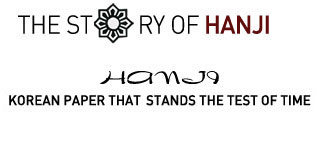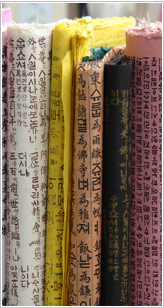
Hanji literally means “the paper of Korea”. The main material is the fibrous skin of the mulberry. Hanji is not simply paper. It is used in a variety of ways, and has a different name according to its use. If it is glued on a door it is called a window paper It is copy paper if it is used for a family registry book, Buddhist sutra or old books, while it becomes drawing paper. if four gracious plants or birds are drawn upon it.
The strong vitality of Korean paper is the reason it can be used in a multitude of ways. There is an old saying that paper lasts a thousand years and textiles (such as silk or hemp) last five hundred, reflecting the superior strength of paper over cloth. Koreans even used Korean paper as a suit of armor after varnishing the lacquer. It is known that the life span of Korean paper is 1,000 years. In the West, products made of paper more than 300∼400 years old are rare. But Korea has preserved quite a few books and drawings which are almost 1000 years old. The most typical example is the , which is the oldest printed material in the world. The year the was created was 751.
 | Korean paper was also very famous as much as Sodongpa, a famous Chinese poet in the 11th century Chinese poet said that he would like to publish his anthology with paper produced from Goryeo (The name of the Korean dynasty at that time), which was one of Korea’s main export good at that time. Koreans use Korean paper made by traditional methods for government documents or other documents. The superiority of Korean paper comes from the material with which it is made. The bark of the mulberry is strong and can endure without decomposition when it is immersed in the water for 1 year. It allows both air and light through as the fibers are wide. High-quality Korean paper can be produced with trees that are only 1 year old, while cheaper modern paper must use the pulp from trees 20~30 years old. |
The manufacturing process of Korean paper is complicated, slow and laborious. The dry mulberry is cut after the frost has arrived and is peeled off after steaming. It is immersed in water for one day and, after being dried under the sunlight, the bark is peeled off, steamed again inside an iron pot and immersed in caustic soda. The steamed bark is smashed inside a stone mortar after the water has been squeezed out. Then it is rinsed in flowing water after being placed inside a wrapper. The washed mulberry is mixed with water and a natural adhesive. Next, the fibers are strained through a bamboo screen, which is shaken back and forth to create a crisscross pattern of fibers. The pulp is then dried by stacking it on a wooden panel and placed in the sun, completing the process. Learn more about the manufacturing procedure of traditional Korean paper through a visit to the Korean paper museum in Jeonju (www.hanjimuseum.co.kr), Jeollabuk-do.
The traditional methods for making Korean paper are not being passed down as greatly as before, making the manufacturing process quite challenging these days. It is such a difficult job that traditional masters of hanji say, “I will not let my son be a container man (the person who strains the fiber through a bamboo screen) even if I am driven to the worst”.

The small quantities, a long production process and distribution limited to specialty markets make it difficult for traditional Korean paper to compete with the mass distribution of cheap easily produced modern paper. The Korean government has therefore appointed the masters of Korean papermaking as intangible cultural assets and protects the industry with special care.
The superiority of hanji has endured despite historical and global changes. There is a trend toward using hanji for another purpose, like for artwork. Artists for calligraphy and dyeing insist on using Korean paper. Black Chinese ink spreads evenly because the paper is strong and lacks impurities despite being thin. Korean paper is used widely in various art industries. Fashion shows for clothing made of hanji have been held on the Champs Elysee in Paris. A study on potential protective properties of hanji paper for space shuttles is currently underway in a joint study by Korea and the USA. Korean paper has been developed for use as a substitute for styrofoam as internal packing material.
Source : visitkorea.or.kr


No comments:
Post a Comment